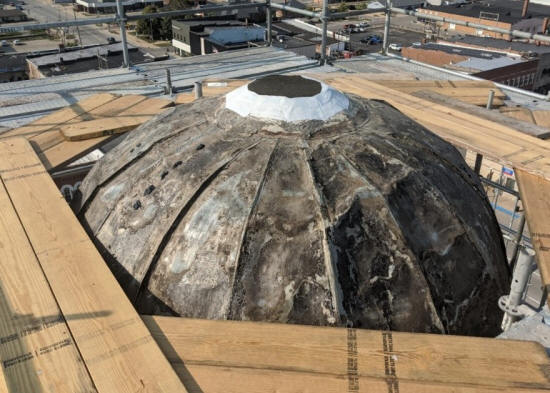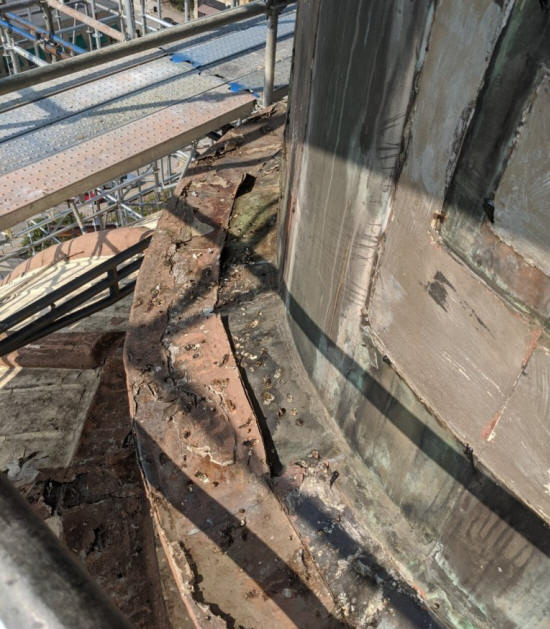|
Logan County Courthouse
restoration: Cupola issues and restoration specifications,
transition plans rolling to keep business as usual
 Send a link to a friend
Send a link to a friend
 [September 09, 2021] [September 09, 2021]
At the Logan County Board’s Buildings and Grounds Committee meeting
on Tuesday, September 7, project manager Bill Walter shared several
updates on the courthouse restoration.
Building and Grounds Committee members present were committee
Chairman David Blankenship, Board Vice chairman Scott Schaffenacker,
Janet Estill, David Hepler and Jim Wessbecher.
Work has begun on the cupola on top of the dome. As they have begun
digging into the cupola, Walter said a lot of the fiberglass has
been removed exposing the copper underneath.

_small.jpg)
As they have removed the fiberglass, Blankenship said they found the
cupola was constructed differently than anticipated.
%20(edited-Pixlr)375_small.jpg)


To restore the cupola, Walter is now looking at two options. He is
considering whether to remove the entire cupola somewhat intact or
leave the cupola in place as it is restored.
Walter is talking to architects, engineers and other consultants
about whether to use copper or precoated metal panels to restore the
cupola. There are valid reasons to go with each one, so Walter said
they are trying to figure out what would yield the best results.
Once the specifications are done, the choice will be presented.

The steel superstructure of the cupola is in excellent condition.
Walter said there is almost no corrosion, though it is full of bird
excrement.
[to top of second column] |

Specifications for the dome restoration are 98 percent done and are subject to
State’s Attorney Brad Hauge’s approval. Once Walter gets the specifications and
bid documents approved, he will ask known contractors to submit bids. Within the
next four weeks, Walter will also advertise for bids from contractors. He is
hoping for four or five bids.
In approximately six weeks or early November, Walter said they should have a
contractor on site.
CTS is working on HVAC plans. The performance contract and construction
management contract are almost ready for preliminary review.
The construction technical committee will meet next week to go over the
construction management contract and dome specifications. In addition, the
committee will review security issues with the architect.

Walter and Blankenship recently had their first meeting with the transition
committee, which is made up of county employees. This committee will be taking
care of relocations, storage, IT and anything that keeps the customer service
portion of the courthouse going.
With good communication from the committee, Blankenship said the meeting went
well. He said Hauge did a good job heading up the transition committee.
From Walter’s perspective, “everyone [was] on the same sheet of music” as far as
plans go. They set the groundwork for what they want to accomplish.
The transition committee will look over maps and floorplans soon. Walter will
listen everyone’s questions, comments or concerns. Through Hauge, Walter has
sent everyone a list of potential questions the committee to consider when
responding and providing their own department input.
Next week, Walter said the transition committee will be considering inside needs
and the retrofitting of the courthouse.
As the transition committee figures out the best use of space, Blankenship said
they will discuss possibly consolidating offices and making space for the public
defender. He said they will continue discussing how to consolidate spaces, how
to manage the space they have and how to place everyone.
The transition committee gets to bring forward decisions on what they think is
best. Walter said the positions and desires of transition committee members were
well stated.
Hepler asked if there had been discussion of office space for the military
recruiters, County Highway Engineer Bret Aukamp or County Zoning Officer Will
D’Andrea.
Looking over interior courthouse space, Walter said they have come up with eight
viable spaces. All three offices were on that list.
Not all the conference rooms are needed since most departments only use their
conference rooms one or two days a month. Walter said one option is to have one
conference room for the whole building. There would then be a calendar provided
for departments to schedule their meeting times.

Walter does not necessarily want people to have to go through several offices to
get to the conference room. Therefore, some people may have to trade offices
with others. He is excited about their willingness to accommodate these changes.
[Angela Reiners] |